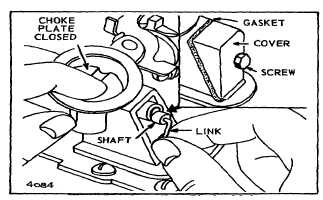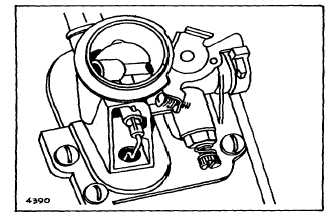TM 5-4240-501-148P
CARBURETION
Automatic Choke
Fig. 15 -- Inserting Choke Link
Move choke plate to an over center position as shown in
Fig. 16. Tighten carburetor mounting screws in a
staggered sequence. Please note Opening the choke to
an over center position places the diaphragm in a
preloaded condition.
Move choke plate to a normal position. Choke plate
should now fully close, Fig. 16.
If choke valve is not fully closed, check to be sure choke
spring is properly assembled to diaphragm, and also
properly inserted in its pocket in the tank top. Install
choke link cover and gasket.
Fig. 16 - Pre-Loading Diaphragm
All carburetor adjustment should be made with the air
cleaner on engine. Best adjustment is made with a fuel
tank half full of gasoline.
To Adjust Carburetor:
1.
Start engine and run long enough to warm it to
operating temperature.
NOTE: If engine is out of adjustment so
that it will not start, close the needle
valve by turning it clockwise. Then open
needle
valve
1-1/2
turns
counterclockwise. Fig. 17.
Fig. 17 - Adjusting Carburetor
2. Move speed control lever to run engine at normal
operating speed.
a.
Turn needle valve in clockwise until engine starts
to lose speed (lean mixture).
b.
Then
slowly
turn
needle
valve
out
counterclockwise past the point of smoothest
operation until engine just begins to run unevenly
(rich mixture).
c.
Turn
needle
back
clockwise
to
midpoint
(smoothest operation) between rich and lean
mixture.
d.
Final adjustment of the needle valve should be
at the midpoint between rich and lean.
3.
Move engine to SLOW. Turn idle adjusting screw
until a fast idle is obtained 1750 R.P.M.
If the engine idles at a speed lower than 1750
R.P.M., it may not accelerate properly. It is not
practical to attempt to obtain acceleration from
speeds below 1750 R.P.M., since the richer mixture
which would be required, would be too rich for
normal operating speeds.
7





